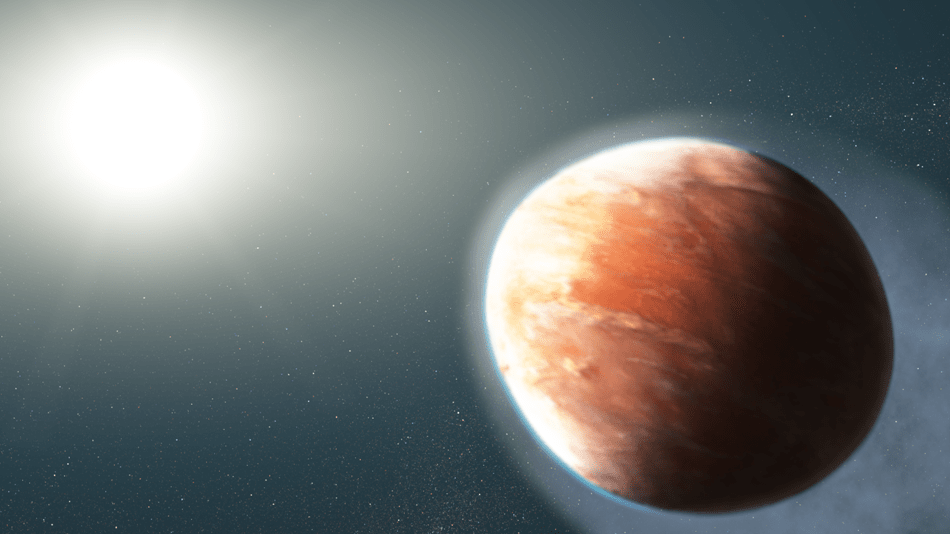Aug 5 2019
When can a planet be referred to as “hotter than hot?” The answer is when it is detected that heavy metals escape from the atmosphere of the planet, rather than condensing into clouds.
 (Image credit: NASA, ESA, and J. Olmsted (STScI))
(Image credit: NASA, ESA, and J. Olmsted (STScI))
NASA’s Hubble Space Telescope has observed gases of iron and magnesium streaming from the unique realm outside the solar system, called WASP-121b. The observations symbolize the first time the so-called “heavy metals”—elements that are heavier than hydrogen and helium—have been detected escaping from a hot Jupiter, a huge, gaseous exoplanet located very close to its star.
In general, the inner side of hot Jupiter-sized planets is still sufficiently cool to condense heavier elements like magnesium and iron into clouds.
However, this is not applicable to WASP-121b, which orbits very dangerously close to its star that the temperature of its upper atmosphere reaches a scorching 4,600 °F. Its upper atmosphere temperature is nearly 10 times more than that of any familiar planetary atmosphere. The WASP-121 system is located approximately 900 light-years from Earth.
Heavy metals have been seen in other hot Jupiters before, but only in the lower atmosphere. So you don’t know if they are escaping or not. With WASP-121b, we see magnesium and iron gas so far away from the planet that they’re not gravitationally bound.
David Sing, Lead Researcher, Johns Hopkins University
The host star, which is hotter and brighter than the Sun, emits ultraviolet light that heats the upper atmosphere and assists in its escape. Furthermore, the magnesium and iron gas that escapes might play a role in the temperature rise, stated Sing. “These metals will make the atmosphere more opaque in the ultraviolet, which could be contributing to the heating of the upper atmosphere,” he explained.
The blazing planet is so close to its star that it is on the brink of being disintegrated by the gravity of the star. This hugging distance indicates that the planet is in the shape of a football owing to gravitational tidal forces.
We picked this planet because it is so extreme. We thought we had a chance of seeing heavier elements escaping. It’s so hot and so favorable to observe, it’s the best shot at finding the presence of heavy metals. We were mainly looking for magnesium, but there have been hints of iron in the atmospheres of other exoplanets.
David Sing, Lead Researcher, Johns Hopkins University
Sing continued, “It was a surprise, though, to see it so clearly in the data and at such great altitudes so far away from the planet. The heavy metals are escaping partly because the planet is so big and puffy that its gravity is relatively weak. This is a planet being actively stripped of its atmosphere.”
The observatory’s Space Telescope Imaging Spectrograph was used by the researchers to search in ultraviolet light for the spectral signatures of iron and magnesium inscribed on starlight that filters through the atmosphere of WASP-121b when the planet passed in front of the face of its host star.
Moreover, this exoplanet is an ideal target for NASA’s forthcoming James Webb Space Telescope to search in infrared light for carbon dioxide and water, which can be detected at longer, or more red, wavelengths. The combination of Webb and Hubble observations would offer astronomers a more comprehensive catalog of the chemical elements constituting the atmosphere of the planet.
The study of WASP-121b is part of the Panchromatic Comparative Exoplanet Treasury (PanCET) survey, a Hubble program to observe 20 exoplanets, the sizes of which range from super-Earths (several times the mass of Earth) to Jupiters (more than 100 times the mass of Earth), in the first large-scale ultraviolet, infrared, and visible comparative survey of distant realms.
The WASP-121b observations contribute to the emerging story of the way planets lose their primordial atmospheres. During the formation of planets, they bring together an atmosphere that consists of gas from the disk from which the star and planet formed. These atmospheres are primarily made of the lighter, primordial gases hydrogen and helium, which are the most abundant elements in the universe. This atmosphere gets scattered when a planet moves closer to its star.
The hot Jupiters are mostly made of hydrogen, and Hubble is very sensitive to hydrogen, so we know these planets can lose the gas relatively easily. But in the case of WASP-121b, the hydrogen and helium gas is outflowing, almost like a river, and is dragging these metals with them. It’s a very efficient mechanism for mass loss.
David Sing, Lead Researcher, Johns Hopkins University
The study outcomes were published online in The Astronomical Journal on August 1st, 2019.
The Hubble Space Telescope is a project of international collaboration between NASA and the European Space Agency (ESA). The telescope is managed by NASA’s Goddard Space Flight Center in Greenbelt, Maryland. Hubble science operations are conducted by the Space Telescope Science Institute (STScI) in Baltimore, Maryland. The Association of Universities for Research in Astronomy in Washington, D.C., operates STScI for NASA.